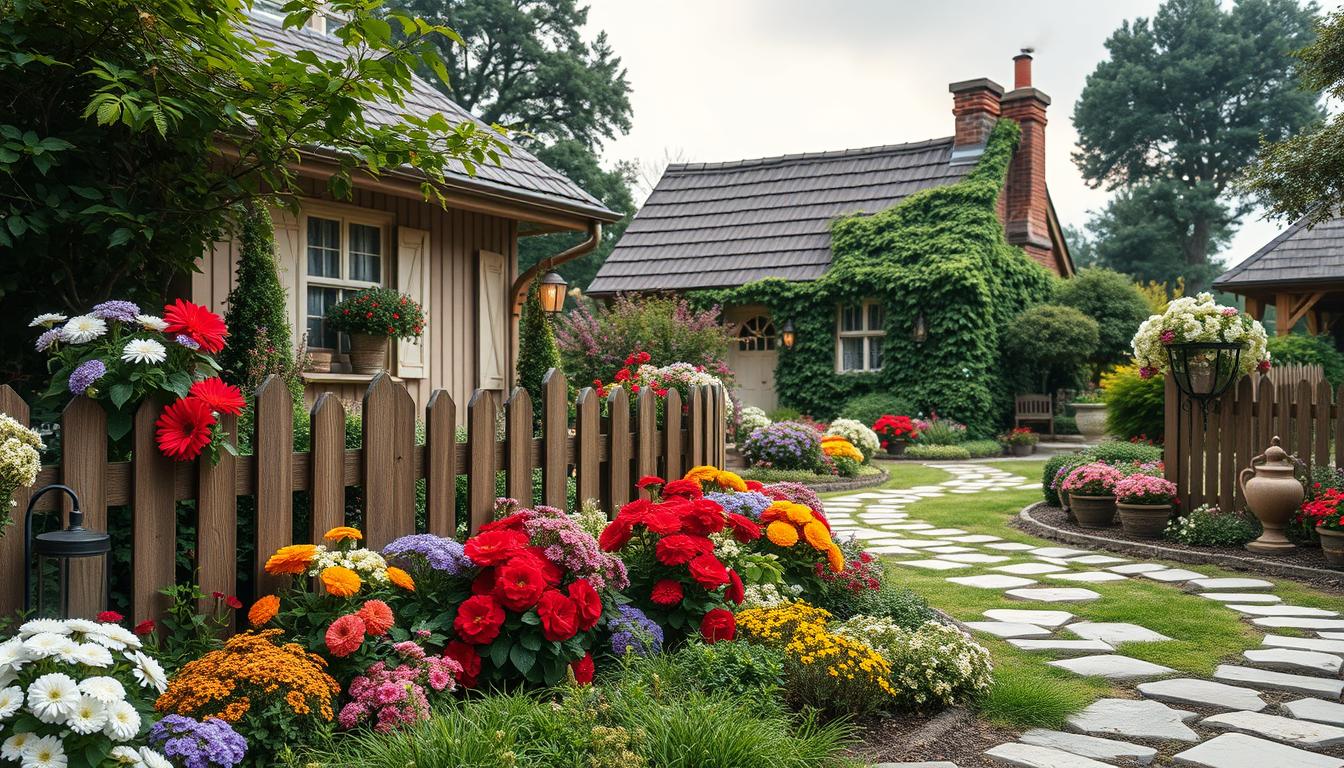I’m excited to share my journey on creating a cottage garden. This type of garden is warm and charming. It’s all about embracing nature and bringing it outside.
To start, you need to know the basics of designing a cottage garden. This includes the layout, plant selection, and landscaping.
In this article, I’ll show you how to create a stunning cottage garden. I’ll give you practical tips and advice. You’ll learn how to choose the right plants and landscaping features.
This will make it easy for you to create a beautiful and functional cottage garden.
What is a Cottage Garden?
A cottage garden is a type of garden that feels cozy and informal. It uses natural materials and has many plants and flowers. To make a beautiful cottage garden, think about design tips and get inspiration from others.
When designing, think about the look you want. Consider the textures, colors, and smells that will make your garden lively.
Key elements for a cottage garden include curved lines and ornamental features. These help create a cozy and private space. Your garden can show your style and be a peaceful escape.
Understanding the Aesthetic
It’s important to understand the look of a cottage garden. Natural materials like stone and wood add warmth and texture. You can also use traditional cottage garden style for inspiration.
Think about adding climbing vines, flower-filled borders, and winding paths. These elements make your garden feel authentic and charming.
Key Characteristics of Cottage Gardens
Some key features of cottage gardens are:
- Use of natural materials, such as stone and wood
- Incorporation of ornamental features, like sundials and bird baths
- Creation of a sense of intimacy and seclusion, using elements like hedges and trellises
- Incorporation of a variety of plants and flowers, including herbs, vegetables, and fragrant blooms
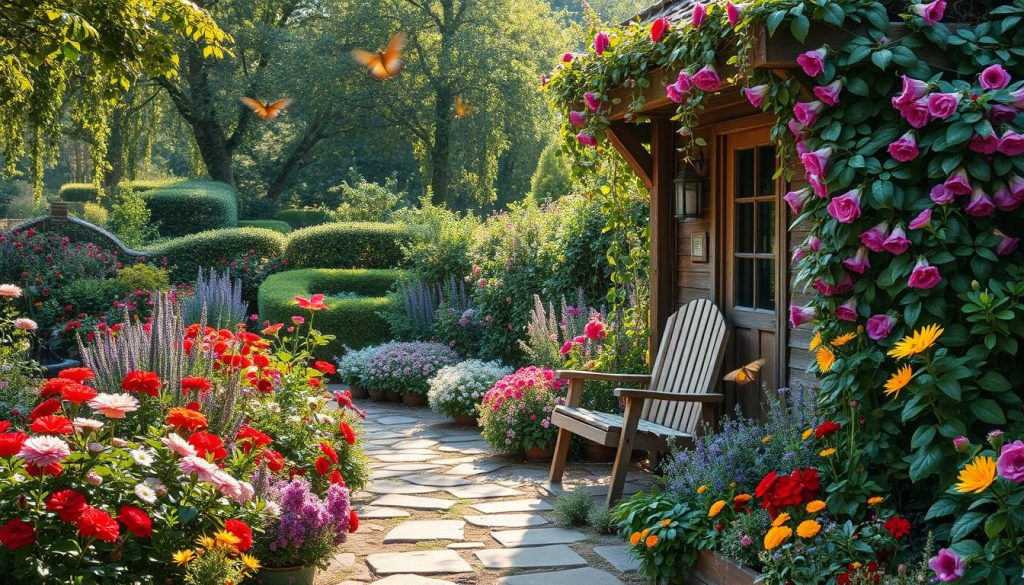
Planning Your Cottage Garden Layout
Creating a beautiful cottage garden starts with planning. A good layout showcases your plants and welcomes visitors. Use a cottage garden planning guide to visualize your space and make the most of it. This is a crucial step in creating your garden.
Start by measuring your garden and planning its layout. Note your garden’s size, shape, and any existing features like trees or patios. This helps you place pathways, borders, and focal points effectively.
Measuring Your Space
Measure your garden by walking around it and taking note of its dimensions. Use a tape measure or a garden app for accurate measurements. Also, consider your garden’s slope, drainage, and sun exposure.
Choosing a Focal Point
A focal point draws the eye to a special part of your garden. It could be a statue, water feature, or standout plant. Choose something that fits your garden’s style and theme. For example, a sundial or birdbath adds elegance to a traditional cottage garden.
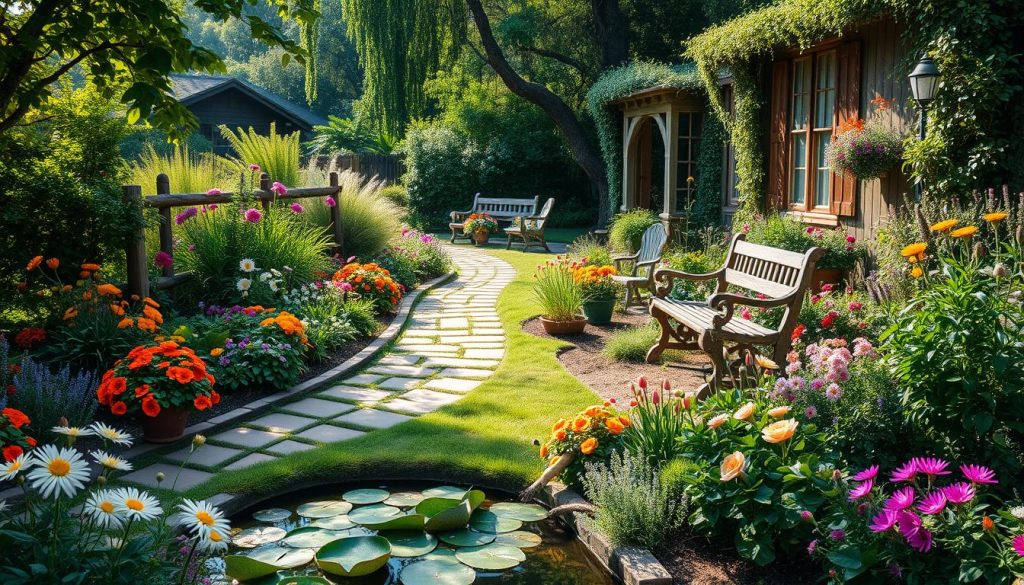
By following these steps and using a planning guide, you can create a beautiful garden that shows your style. Take your time and enjoy the journey of creating your cottage garden.
| Garden Feature | Description |
|---|---|
| Pathways | Meandering paths that lead to different areas of the garden |
| Borders | Defined edges that separate different sections of the garden |
| Focal Points | Statement features that draw the eye to a particular part of the garden |
Selecting the Right Plants
Creating a beautiful cottage garden starts with the right plants. I choose plants native to my area and that love my local climate. This makes my garden easy to care for and saves resources.
Choosing the right plants is key to a stunning cottage garden. I look for plants that are pretty and bring peace. Roses, peonies, and hydrangeas are favorites for their elegance.
Popular Flowers for Cottage Gardens
- Roses
- Peonies
- Hydrangeas
I also add herbs and vegetables to my garden for variety and usefulness. Plants like lavender, rosemary, and tomatoes are great. They’re good for cooking and making herbal remedies.
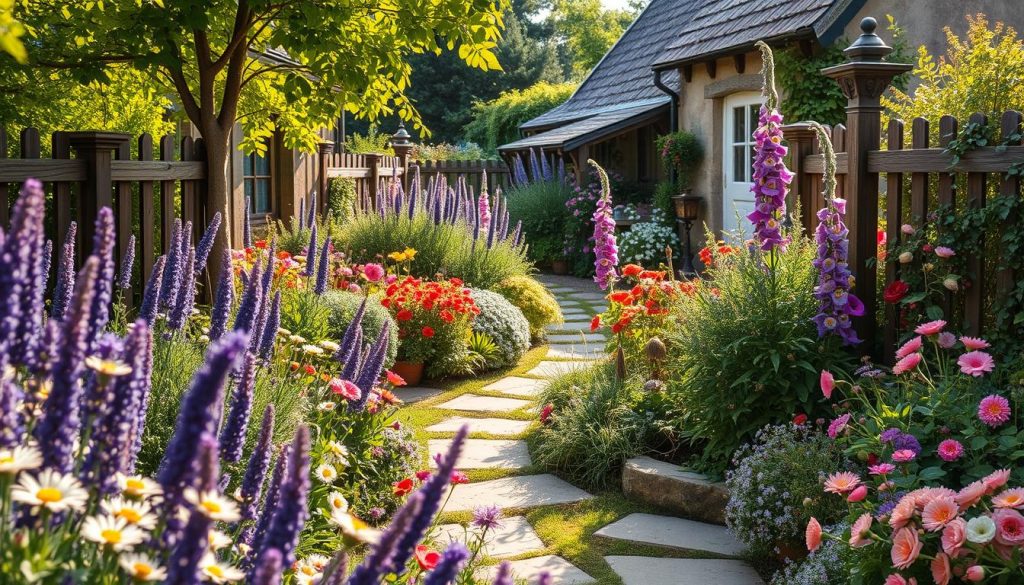
Incorporating Herbs and Vegetables
By picking the right plants, I create a beautiful and useful outdoor space. Whether I want a calm spot or a lively area, a cottage garden fits the bill.
| Plant | Benefits |
|---|---|
| Roses | Visually appealing, fragrant |
| Lavender | Calming, attractive to pollinators |
| Tomatoes | Edible, easy to grow |
Soil Preparation: The Foundation
To create a charming cottage garden, start with a solid foundation. This foundation is soil preparation. The quality of the soil is key to your garden’s health and success. Testing your soil and knowing its pH level helps improve its health and make it fertile and well-draining.
Improving soil health is vital for a charming cottage garden. Adding compost or manure enriches the soil and gives plants essential nutrients. Using natural fertilizers and avoiding harsh chemicals keeps the soil’s ecosystem healthy and promotes plant growth.
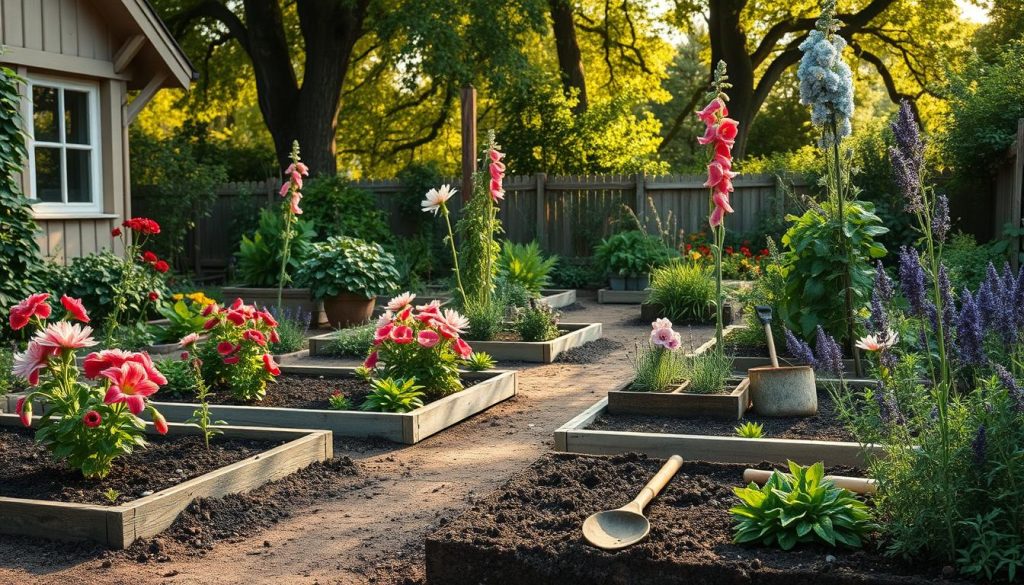
Testing Soil Quality
Testing your soil quality is easy with a DIY kit or by sending a sample to a lab. The results tell you about your soil’s pH level, nutrient content, and structure. This information helps you improve your soil’s health.
Improving Soil Health
After knowing your soil’s quality, start improving it. Add organic matter, fertilizers, or other amendments to make the soil balanced and fertile. By following these steps and using effective planting techniques, you’ll have a thriving and charming cottage garden. It will bring you joy and beauty for years.
| Soil Type | pH Level | Nutrient Content |
|---|---|---|
| Clay | 6.0-7.0 | High in nutrients, but prone to waterlogging |
| Sandy | 6.0-7.0 | Low in nutrients, but well-draining |
| Loam | 6.0-7.0 | Balanced nutrient content, well-draining |
Planting Techniques That Work
Creating a beautiful cottage garden starts with the right planting techniques. Understanding how to plant and care for your garden is key. This way, your garden will look great and stay healthy.
Start by using companion planting. This means growing different plants together to help each other. For example, marigolds can keep nematodes away from tomatoes. Basil can make lettuce taste better.
Companion Planting Strategies
- Plant marigolds with tomatoes to repel nematodes
- Plant basil with lettuce to improve its flavor
- Plant beans with corn to provide support and improve growth
When to Plant Different Species
Knowing when to plant is crucial. You need to consider the weather, soil, and moisture. A step-by-step plan helps you plant at the best time for each species.
| Plant Species | Best Time to Plant |
|---|---|
| Tomatoes | Spring, after the last frost |
| Marigolds | Spring, after the last frost |
| Basil | Summer, when the weather is warm |
Adding Pathways and Borders
To make your cottage garden more beautiful and useful, think about adding pathways and borders. They help create a cozy feel and separate different parts of your garden. Pathways and borders are key in tying your garden together.
For tips on cottage garden design, pick walkway materials that are natural and strong, like stone or brick. These materials will match your plants and flowers, making your garden look unified. Also, think about the color and texture of these materials to make sure they fit well with your garden.
Choosing Materials for Walkways
- Stone: A popular choice for pathways, stone is durable and comes in a variety of colors and textures.
- Brick: Brick pathways are classic and timeless, adding a touch of elegance to any cottage garden.
- Gravel: A more rustic option, gravel pathways are easy to install and maintain.
Creating Defined Edges
It’s important to have clear edges in your garden to keep it organized and structured. Use materials like wood or metal for borders that match your pathways and plants. This will help your garden look balanced and beautiful, making it a great place to relax outside.
Adding pathways and borders to your cottage garden design makes it unique and welcoming. Choose materials and designs that go well with your plants and flowers. Don’t be afraid to try out different ideas to find the perfect look for your garden.
| Material | Color | Texture |
|---|---|---|
| Stone | Gray, Beige, Brown | Rough, Smooth |
| Brick | Red, Orange, Yellow | Rough, Smooth |
| Gravel | Gray, Brown, White | Small rocks, Pea gravel |
Incorporating Garden Furniture
To make a charming cottage garden, adding the right garden furniture is key. Think about the style and use of the furniture. Choose comfy seating like benches or chairs and useful decor like tables or planters.
Some great choices for garden furniture include:
- Benches from natural materials like wood or stone
- Chairs with cushions in soft, pastel colors
- Tables with built-in planters for extra greenery
When picking furniture, match it to your garden’s theme and style. For instance, a rustic wooden bench fits well in a garden with a rural feel. Garden furniture makes your garden welcoming and perfect for relaxing or having fun. It boosts your garden’s beauty and use, making it a great place to relax outside.
Adding these elements makes a beautiful and useful outdoor area that shows your style. A charming cottage garden balances beauty and function well. Garden furniture is a smart way to get this balance right.
Attracting Wildlife to Your Garden
To make your garden a thriving ecosystem, think about attracting wildlife. When you learn how to create a cottage garden, remember to choose plants that attract birds, bees, and other creatures. Your garden should have a mix of flowers, herbs, and shrubs that offer nectar, pollen, and seeds.
Creating a space that’s friendly to pollinators is key. Plant a variety of flowers like sunflowers, lavender, and coneflowers. These plants give bees and butterflies a source of food.
Creating a Pollinator-Friendly Space
- Plant a variety of flowers that bloom at different times to provide a constant source of nectar and pollen
- Incorporate native plants that are naturally attractive to local wildlife
- Avoid using pesticides, which can harm or kill pollinators and other beneficial insects
Providing Water Sources
Water sources, like birdbaths or ponds, are vital for attracting wildlife. They offer drinking water and a place for animals to bathe and cool off. Adding these features to your garden makes it welcoming for local wildlife.
Seasonal Care for Your Cottage Garden
To keep your cottage garden thriving, following a seasonal care guide is key. Each season brings different needs for your garden’s health and beauty. A well-planned garden can make your outdoor space stunning all year.
In spring, I plant cool-season crops and add compost to the soil. This gives my plants a nutrient boost. It’s also a good time to check my garden’s layout and make changes if needed. This ensures my garden stays in top shape.
When fall arrives, I focus on maintenance. This includes cleaning up debris and getting my garden ready for winter. I cut back perennials, add mulch, and fix any garden paths or borders. With a good care plan, my garden stays beautiful all year.
Spring Planting Tips
- Plant cool-season crops, such as broccoli and kale
- Incorporate compost into your soil to enrich its nutrient content
- Assess your garden’s layout and make any necessary adjustments
Fall Maintenance Activities
- Clean up debris and dead plant material
- Cut back perennials to prepare them for winter
- Add a layer of mulch to protect your plants from extreme temperatures
Managing Garden Pests Organically
Creating a charming cottage garden means keeping pests away. I’ve found that using natural methods is key. Introducing beneficial insects like ladybugs and lacewings helps control pests like aphids and whiteflies.
Using physical barriers, like fine-mesh screens, also works well. I add plants that attract beneficial insects, like coneflowers and black-eyed susans. This approach helps my garden stay healthy without chemicals.
- Companion planting: pairing plants that repel pests, like basil and mint, with plants that are susceptible to pest damage
- Crop rotation: rotating my plants to break the life cycle of pests and reduce the risk of infestation
- Hand-picking: manually removing pests from my plants to prevent them from causing damage
By using these methods, my garden is balanced and pest-free. It grows well with little help from me.
| Pest Control Method | Benefits |
|---|---|
| Companion Planting | Repels pests, improves plant growth |
| Crop Rotation | Breaks pest life cycle, reduces infestation risk |
| Hand-picking | Removes pests, prevents damage |
Celebrating Your Cottage Garden
After all the hard work, it’s time to enjoy your beautiful cottage garden. Hosting a garden party is a great way to celebrate. Set up comfy seating, offer drinks and snacks, and let your garden shine.
How to Host a Garden Party
Invite family and friends for a relaxing afternoon in your garden. Use wicker chairs or a wooden bench for seating. Add colorful throw pillows for comfort.
Offer lemonade, iced tea, or a special cocktail. Choose light snacks or a fresh produce grazing board.
Sharing Photos on Social Media
Share your garden’s beauty with the world! Take photos of your blooms, pathways, and seating areas. Post them on social media with hashtags like #cottagegarden and #gardeninspiration.
Your garden might inspire others to create their own garden paradise.

